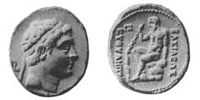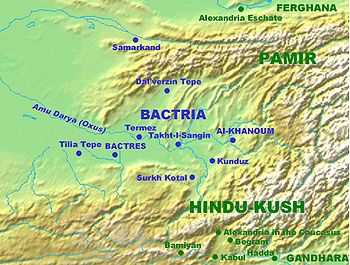Alexandria Eschate
Coordinates: 40°15′N 69°38′E / 40.250°N 69.633°E

Alexandria Eschate (Greek Ἀλεξάνδρεια Ἐσχάτη, Latin: Alexandria Ultima, English meaning "Alexandria the Farthest") or Alexandria Eskhata was founded by Alexander the Great in August 329 BCE[1] as his most northerly base in Central Asia. It was established in the southwestern part of the Fergana Valley, on the southern bank of the river Jaxartes (modern name Syr Darya), at the location of the modern city of Khujand, in the state of Tajikistan. (Khujand is also written Хуҷанд, خجند, Khüjand, Khodzhent, Khudchand, Chodjend. It has also been called, since Alexander: Ispisar, Leninabad, Leninobod, Ленинобод, لنینآباد.)
Alexander built a 6 kilometer brick wall around the city which, according to the ancient authors, was completed in only about twenty days.[2] As at the other cities he founded, he settled a group of his retired wounded veterans there.
A Hellenistic outpost in Central Asia

Alexandria Eschate was located around 300 km (186 mi) north of Alexandria on the Oxus in Bactria, and being in Sogdian territory had to sustain numerous conflicts with the local population. After 250 BCE, the city probably remained in contact with the Greco-Bactrian Kingdom centered on Bactria, especially when the Greco-Bactrian king Euthydemus I extended his control to Sogdiana.
Archeaology
The remains of Alexander's town lie in the tell of the old citadel in Khojand. Although the oldest surface remains of the walls date only to the tenth century, Soviet and Tajik excavations of the site have revealed that below the modern surface are mediaeval, Hellenistic and Achaemenid layers. These layers have revealed fortifications dating to around the fourth century BC.
Other remains include household utensils, armaments and building materials which are exhibited in the Museum of Regional Studies in Khojand. The site has also revealed numerous Hellenistic coins and pottery.[3]
Contacts with China
The city was also located around 400 km (249 mi) west of the Tarim Basin, today's region of Xinjiang in China, where the Yuezhi, an Indo-European people were established. There are indications that Greek expeditions were led as far as Kashgar in Xinjiang. According to the Greek historian Strabo, the Greeks "extended their empire even as far as the Seres and the Phryni" (Strabo XI.II.I), possibly leading to the first known contacts between China and the West around 200 BCE.
The descendants of the Greeks in Ferghana may be the Dayuan (lit. "Great Ionians") identified in the Chinese historical record of the Han Dynasty, starting with the embassies of Zhang Qian around 130 BCE. If so, they were the actors of the first major interaction between an urbanized Indo-European culture and the Chinese civilization, which led to the opening up the Silk Road from the 1st century BCE.
According to the Roman writer Curtius, the descendants of these soldiers still retained their Hellenistic culture at the time of his writing, around 30 BCE.
In fiction
Alexandria Eschate is the final destination of Euxenus, son of Eutychides of the deme of Pallene, the protagonist of Alexander at the World's End by Tom Holt.
Horses of Heaven, by Gillian Bradshaw, is set in Alexandria Eschate, c.140 BCE.
Footnotes
- ↑ Prevas, John. (2004). Envy of the Gods: Alexander the Great's Ill-Fated Journey across Asia, p. 121. Da Capo Press, Cambridge, Mass. ISBN 0-306-81268-1.
- ↑ Leriche, Pierre. (1993). "L'extreme-orient hellenistique: Le monde de la brique crue." Les Dossiers d'Archeologie. No. 179, Fevrier 1993, p. 82.
- ↑ Negmatov and Belyaeva 1977, Raskopki na tsitadeli Leninabad i lokalizatsiy a Aleksandrii Eskhati. Harmatta 1994 p.100
References
See the notes on "Northern Wuyi" = Alexandria Eschate in the draft annotated translation of the 3rd-century Chinese history, the Weilüe, by John Hill at: and